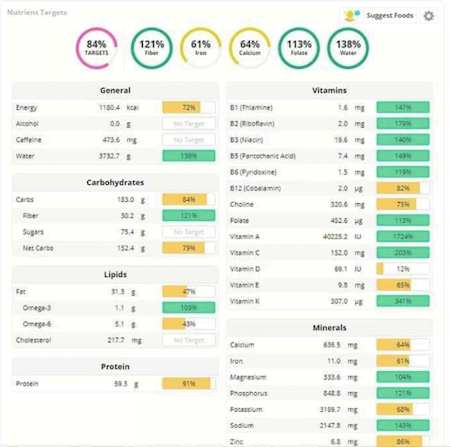
Price: Wholesome is a flat $3.99 for lifetime. Currently, this app is only available for iOS. However, beginners might prefer this app, because it's simpler than Cronometer and has a more complete database than Wholesome. Its food recommendations are the worst of the three apps. I dislike that it uses dials instead of progress bars for micronutrients. Its poor search for food names is a sufficient reason to rank it last, but I'm also not thrilled with the main display, wasting almost a full screen for just a nutrition meter. Nutritrack is my least favorite of the three. For those who want to use the app on Android or web, Cronometer is the only option out of these three apps. The subscription version also has extensive graphing over time, which I love, though much of that is available for Apple users in the Health app. However, for balancing nutrients, such as omega-3 and omega-6, the subscription version has some helpful gauges. Although it has a superior database and searching, the interface is ugly, text-heavy, and some of its few graphics are more confusing than informative. If you have an Android phone, sell it and buy an iPhone so you can have Wholesome.Ĭronometer takes second place for me. Also unfortunately, Wholesome is currently an iOS only app.

It's nothing you can't learn to live with. Note: if you enter your own photos for custom foods and recipes, use generic photos for example, if you enter a can of salmon as a custom food, take a photo of the salmon meat, not the can! Unfortunately, with Wholesome's superior user interface design comes some glitches, inconsistencies, and bugs. Almost everything is selectable for more information, which is enlightening and educational. This makes using Wholesome a qualitatively different experience. The pictorial approach is not only beautiful - it's informative and easy to visually scan. The best food sources for particular nutrients and for your current overall nutritional needs are, you guessed it, photos.

Wholesome wins overall in my eyes, because of its photo-heavy approach. For some additional screenshots, follow this link: That is how the daily food diary/log looks for each on an old iPhone. Since this post is a thousand words, let's start with a picture that may be just as valuable: I tried the paid versions of each, triple logging for four days as well as many more days individually.įirst I'll show you how they look, then give my opinions, more details, and a feature comparison table. The three micronutrient tracking apps I'm going to review are Wholesome, Cronometer, and Nutritrack. If nothing else, I've found that tracking micronutrients is fun, and I find myself eating better than when I only tracked macros.

I'm not a nutrition expert - quite the opposite - but I like the idea of tracking micronutrients, because studies have shown that vitamin and mineral supplements can increase the risk of cancer. This is my review of three micronutrient tracking apps.


 0 kommentar(er)
0 kommentar(er)
